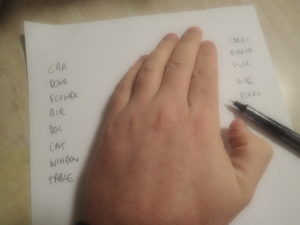We left off last on the topic of how to create a study plan or program, and the value of creating a fixed study schedule of several one hour sessions per week. While the order (whether it’s vocabulary-building, conversation, grammar exercises etc.) is not too important, but since we’ve already established that a lot of people need a fixed program in order to guide them, “how to learn Spanish vocabulary” is going to be our first session.
Session 1: One hour of learning vocab (not verbs). Thirty words in total.
- Write some flashcards with English on one side and Spanish on the other. Use them for twenty minutes and try to commit ten words to memory. One thing you might like to do is line the cards up on your left-hand-side, with the English words facing up. Pick them up, one by one, and try to say the Spanish word that corresponds. Keep doing this until you can get all of them. Now do the reverse, putting them back in a pile to the left, but this time with the Spanish words facing up. When you have learned all the words from English to Spanish and vice versa, put them in a jar. Keep growing this jar over the course of several months. When you have accumulated a number of ‘learned words’, take them out and start the process all over. You might have forgotten a large number, but the second time around, they will become more easily committed to memory.
- For the next twenty minutes, write out a list of ten different words. Cover them and try to rewrite them. Try to commit all ten to memory.
- Spend the last twenty minutes putting a different list of ten words into basic sentences. Use the rules regarding sentence structure you have learned from Spanish class and use sentences from the exercises as templates to form new sentences. E.g.: word: mango (mango). Voy a comer un mango (I’m going to eat a mango). Word: azúcar (sugar). El azúcar es muy dulce (sugar is very sweet).
- Keep a log of all your learned words. Start writing your own homemade dictionary. There are heaps of possibilities. Remember that thirty words a week are over 1, 500 words a year (not including the other words you’ll pick up from your other study days).
*Play around with the allocation of words, i.e.: after week one, transfer unlearned or stubborn words to different twenty-minute activities (don’t forget to keep adding new words). For instance, if the word entonces (so, then) didn’t get embedded in your brain via the flashcards, then add it to your list of words to put into sentences. To vary it even further, after a few weeks, you could allocate several one-hour sessions to just doing flash cards, or solely writing sentences with specific words.
So where do you get all these words? Try searching online for ‘100 most common words in Spanish’. I’m sure the search will yield multiple results! You could plunder the net for other vocabulary lists of common words (just google ‘common Spanish words’ or ‘essential Spanish words’ or something along those lines). Next, start to use any vocabulary lists provided in the coursework given to you by your Spanish school or tutor, as well as any grammar /exercise book (s) you may have. All memorised? Take a look around the house at all of the everyday domestic things which are now unrecognisable because of the papier maché coating of post-it stickers covering them. Add these things to your vocabulary lists. Exhausted everything in the house? Try the garden. Finished with that? When you’re out driving, walking the dog, in the shopping centre or walking the dog in the shopping centre, have a look around you and think of common objects to add, such as ‘traffic light,’ ‘sign’, ‘pavement’ etc. These are all important words and there are no shortages of word resources. Don’t stop until you have to start adding words like ‘quantum physics’, but even then you should probably not stop! Ok, that might be taking it a bit too far…for now…
Next up, learning grammar!

